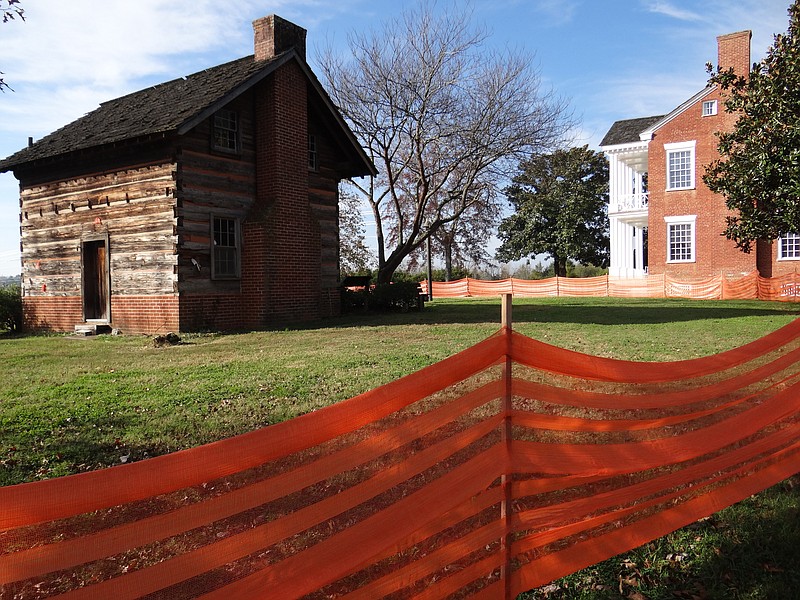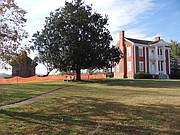A two-story log cabin housing the kitchen and workhouse exhibit at the Chief Vann House in Spring Place, Georgia, is undergoing a complete exterior restoration. Department of Natural Resources officials say that while the cabin will be closed for a couple of months, the rest of the site will remain open to visitors.
The restoration work includes new cedar-shake roofing shingles, window sills, faux chinking and log beams to replace rotten ones, according to Vann House interpretive ranger Irina Garner.
Garner said the restorative work is organized by the state and funded in part by a donation from Friends of the Vann House, an auxiliary of the Whitfield-Murray Historic Society.
The cabin east of Chatsworth, Georgia, was originally part of an office as well as a staff residence until 2002, when the Robert E. Chambers Museum opened to house the site's gallery theater and offices, Garner said Wednesday.
"Then the two-story cabin in question got turned into an exhibit about African-American enslavement in the early 19th century," Garner said.
That is something of a rarity, she said.
"There are not many North Georgia historic sites that have exhibits about enslavement and what enslavement looked like and meant for the people being enslaved and their families," she said. "Unfortunately the building has not gotten a strong restoration in a while, so we're really happy to have one now."
TCC General Contracting is the contractor on the project and work is tentatively set for completion in January, officials said.
The restorative work on the cabin at the Chief Vann House is very detailed work, TCC owner Bill Deaton said Wednesday.
"We've got the inside pulled apart, categorized and stored, and we should start next week replacing some of the logs," Deaton said.
"It's pretty in-depth," he said of the process.
"To replace an exterior log, we have to disassemble the whole inside finish of the walls and the ceiling and everything because it's all attached to those logs," Deaton said. "So we have to disassemble it, mark it, categorize it and then store it. And then we have to lift the roof, shore it and take logs out. It's a tedious process."
Deaton said crews would probably finish the new cedar shake roof Saturday as they continue work on the rest of the cabin.
The company did a similar project on a Cherokee cabin at the New Echota Historic Site in Calhoun, Georgia, about three years ago, Deaton said.
IF YOU GO
The Chief Vann House Historic Site museum’s winter schedule will begin Dec. 3 and remain in place until March 28. Staff will host tours Thursday through Saturday, 9 a.m.-5 p.m., with the last tour starting at 4 p.m. daily. The museum and Vann House will be closed Sunday through Wednesday. To accommodate social distancing, tours will be held every half hour with a maximum of six people per tour. For more details, call 706-695-2598">706-695-2598. Admission is $5.50-$6.50 per person.
THE VANN HOUSE STORY
Cherokee Indian Chief James Vann, known as the wealthiest Cherokee, built what was known as the "Showplace of the Cherokee Nation" in 1804, according to historical information from Vann House interpretive ranger Irina Garner. The house, which underwent some restoration in 2018, stands today near the crossroads west of Chatsworth where Vann gave land and his support to the first school for Cherokee children, the Springplace Mission and School.
(READ MORE: Archaeological work underway near God's Acre Cemetery at North Georgia's Vann House)
During the 1790s, James Vann became a Cherokee leader and wealthy businessman, establishing the largest and most prosperous plantation in the Cherokee Nation, covering 1,000 acres of what's now Murray County and operated with the labor of more than 100 slaves. Several of his businesses lined the road.
The cabin currently being restored was part of the original operations.
After he was killed in 1809 at nearby Buffington's Tavern, James Vann's young son, Joseph, inherited the mansion and plantation and also became a Cherokee leader.
Joseph Vann's wealth even exceeded his father's, according to historical information on the Vanns. He would become known as "Rich Joe."
But in the 1830s, nearly all the Cherokee were forced west by state and federal troops on the infamous Trail of Tears. The Vann family lost its beautiful home and reestablished itself in the Cherokee Territory of Oklahoma, according to state records.
VISITORS AND TOURS
During construction, the museum is open and visitors can tour the antique log cabins in the historic site's 19th century Cherokee farmstead exhibit, take a guided tour of the Vann House and walk the mile-long nature trail to the historic God's Acre Moravian Cemetery, Garner said.
Even though the Vann House is not hosting its annual "Candlelight Tours" event in 2020, Friends of Vann House volunteers will work with park staff to decorate the historic plantation home for an early 19th century Christmas celebration, according to Garner.
Visitors to the Vann House in December will see it decorated "in its finest yuletide majesty," Garner said.
In the year 1800, 220 years ago, the Moravian Missionaries were only just setting up the first Christian mission and school for the Cherokee in their newly purchased plantation barely a mile east of the Vann's Plantation.
"In the Moravian's documents we can read about the first Christmases to be celebrated in the Cherokee nation, including one of the earliest written accounts of a Christmas tree in Georgia," Garner said.
Since 1978, volunteers and staff have kept the spirit of a simple Moravian Christmas alive with fresh greenery, lit candles, quiet music, advent wreaths, nativity scenes and written scriptures that were once gifted to the Cherokee students of the missionaries, she said.
Contact Ben Benton at bbenton@timesfreepress.com or 423-757-6569. Follow him on Twitter @BenBenton or at www.facebook.com/benbenton1.

